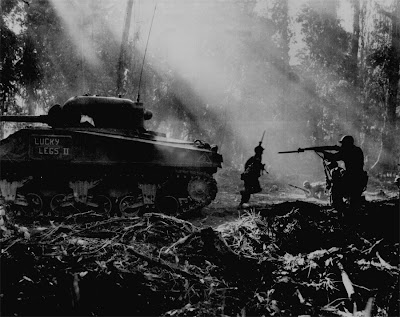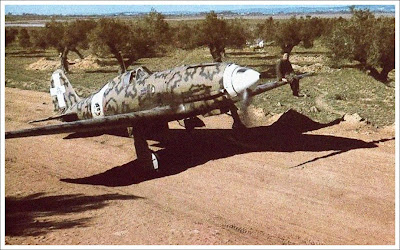Matt is a family friend over in the UK. He is a World War II vet and we respect him a lot for it. Matt likes to send things out over the email machine. Yesterday he sent me this incredible collection of World War II pictures, and I responded:
These pictures are amazing, Matt. What's incredible is I grew up hearing stories of what you guys did in the great World War II, watching it on TV and in the movies . . . The Longest Day . . . The Dambusters . . . Cockleshell Heroes . . . To Hell and Back . . . They Were Expendable . . . The Bridge Over The River Kwai . . . Patton . . . A Bridge Too Far . . . during my upbringing in Southeast Asia and then later during the course of my military service I visited so many of the places depicted in these photos and in the movies, and met and spoke with the soldiers who fought in those terrible battles: Wake Island (I've been there four times!) Okinawa (four YEARS), Kwajalien, Guam, River Kwai, Malaya, Singapore (my brother was BORN there of course - while it was still a British colony!), Hong Kong, former Yugoslavia (all over), Malta, North Africa (from Egypt to Senegal), Normandy, Belgium and of course Stuttgart . . .
Kwajalein: Japanese Kawanishi H8K seaplane after strafing.
Squad of Rufe's at Bougainville. These things were very nimble even with the pontoons.
The A6M2-N float plane version of the Zero did extremely well, suffering only a small loss in its legendary maneuverability. Top speed was not affected, however, the aircraft's relatively light armament was a detriment.
Snow on the flight deck of the USS Philippine Sea, North Pacific 1945.
HARVS on the way in. Rare gun camera shot by a P-47.
Deck crew climbing up to get the pilot out. He did. That’s a fuel tank his foot is on. Empty?
Marines disembark LST at Tinian Island.
Bougainville
Guam
Outside Bastogne
German 280mm K5 firing.
U.S. Munitions ship goes up during the invasion of Sicily. Notice the dried-out spots of salt water on the lenscover from when the photographer waded ashore.
V-1
Spitfire "tipping-off" a V1. If you've never heard of this insane tactic . . .
At first the V1's were shot down by gunfire. Optimum range was inside 200yds, which was marginal for survival. Many planes were damaged and quite a few pilots killed. Basically at such high speed and low altitude a plane had to fly though the explosion and hope. With the high risk of being blown up some of the best pilots started tipping the V1's wing, because of damage to wing tips they later developed a tactic of disrupting the airflow by placing their wing very close to the V1's wing, causing it to topple.
Not every pilot did this. At night this was not possible; the flame from the V1 blinded the pilot to everything else, though some Mosquito pilots flew past closely in front of the V1, again causing it to topple. The thought of doing this at 450mph, 4,000 feet above the ground, at night and being blinded gives me the willies.
Panzerkampfwagen VI E "Tiger"
JU 88 loading a torpedo. This is one HUGE bomber . . . AND it's on pontoons!
German "KARL" motars, Sebastopol
Reloading a KARL
BOOM!
Macchi 202v
Italian 303 Bombers over North Africa
Of course my generation of soldiers were trained & led by Vietnam vets, and we read everything we could get our hands on about the war in Indochina.
We arranged our web gear like they did - used canteen covers for mag pouches because they carry 5 instead of three . . .
The old cotton suspenders with the double straps in the back were prized over the single "Y" strap on the newer LCE because they distributed the weight more evenly - we used to cut out the padding because it absorbed rainwater like a sponge - M14 mag pouches if we could find them in the Hoo-ah stores down on Yadkin Road, and of course the ubiquitous "buttpack" - I've still got a few of them around the place.
We even modified 2 quart canteen covers for SAW magazine pouches - yes I know they didn't have 2 quarts in 'Nam and I know they didn't have M249s, the inspiration was learning from our predecessors how to modify our web gear.
They taught us how to tie things down on our LCE and on our rucks with parachute cord, to cut down on the weight of all those metal clips; they taught us about sewing claymore pouches onto the top flap so you could have a pre-prepped claymore mine with a 6-second fuze for counter-ambush 'break contact' drills - just like they did - cut back the brim on our 'boonie hats' so we could look "up" in the jungle, dogtags in our boot laces, the whole nine yards.
Then we spent 20 years training in the deserts, in many cases rehearsing on the same terrain for the war we're fighting on now, and the funny thing is it took the Army the better part of 15 years to figure out you can't maneuver too far in the desert dismounted with a huge ruck on your back. You need wheels to fight in the desert . . .
US Army Special Forces in Iraq
Those Who Came Before: World War II British SAS Long Range Desert Group, North Africa
. . . and you need to be thinking in terms of 5-gallon water cans, not 2 quart canteens - the Israelis taught us that.
By the time I retired in 2008 there were STILL one or two Vietnam vets in the service, but it was like this: I was born closer to the end of World War II (13 years) than these young sprouts coming in were to Vietnam.
I salute your generation of soldier, Matt! You guys set the standard and set the example for all to follow. You guys fought The Big One. Nothing before or since ever came close.
SEAN LINNANE SENDS
.
Today's Bird HERE
.
Monday, July 11, 2011
Subscribe to:
Post Comments (Atom)








































































Hey Sean, I just about od on memory lane/ got say; I JUST LOVED IT!!!!!/ has it been that long?????? Wow
ReplyDeleteSL,
ReplyDeleteI've been to Wake Is. too and it was pretty awesome being in a place from WWII history.
I started my mil career in the Marine Corps in 1984 and I used (bought) the H-Harness too, instead of the shitty Y-Harness for the same reasons you mentioned. There were still some 'Nam vets in the USMC, but many of them had retired, by the time I got out in 1988.
thebronze
The aircraft labelled as a JU88 is actually a He 115
ReplyDelete